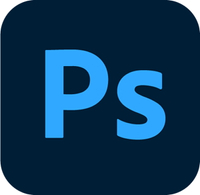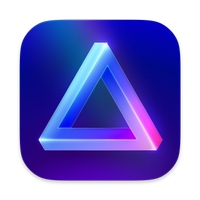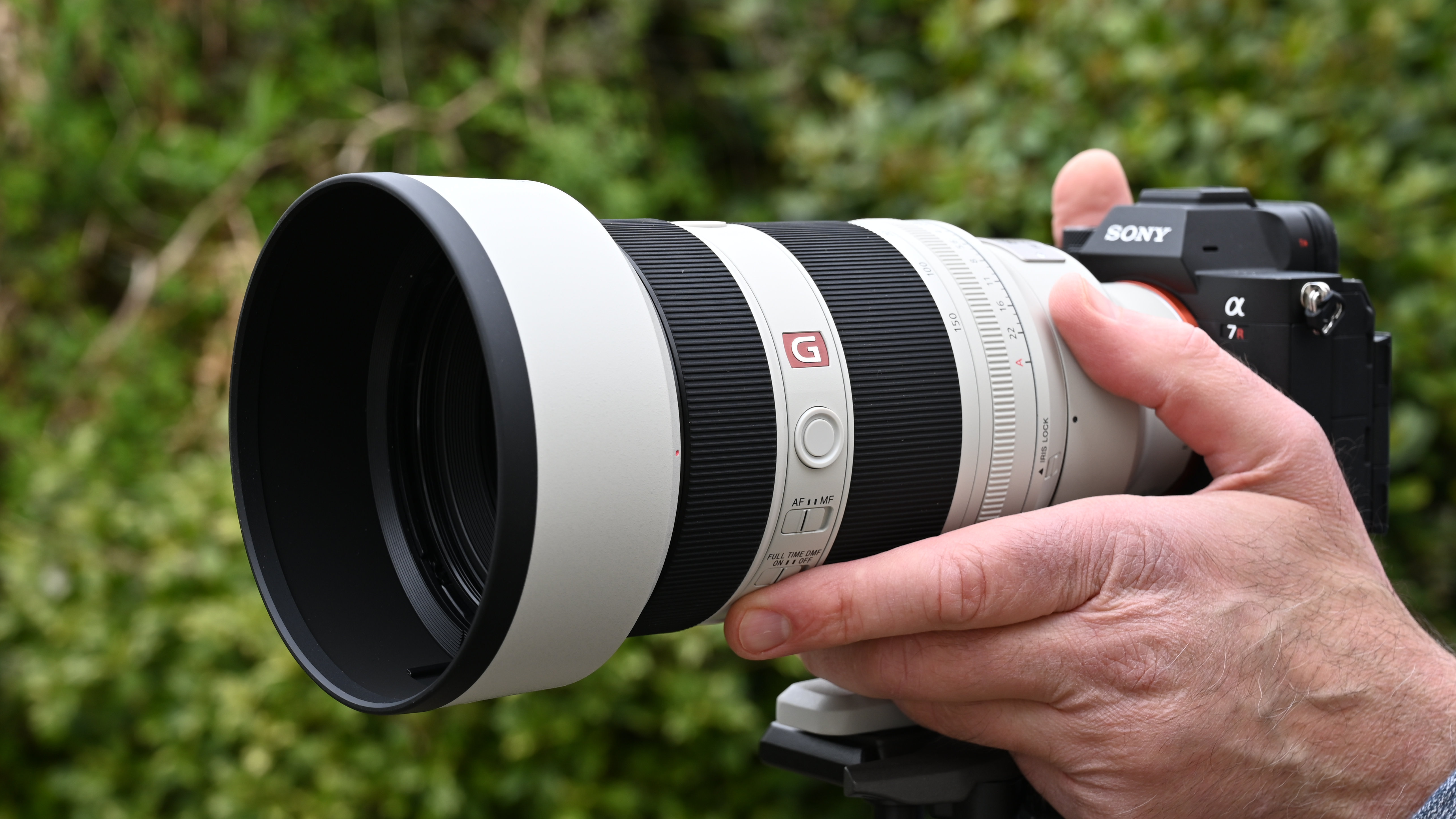The best free photo editing software: fix your photos for free!
Get sophisticated features at zero cost, with the best free photo editing software for desktop and mobile

The best free photo editing software is increasingly impressive in 2023. Okay, it won’t give you all the high-end features of full Photoshop. But it does let you do a lot of common photo editing tasks, without paying a penny. So if you're short on cash, or just being careful with money, it's worth checking whether you actually need to pay for an expensive subscription, or if free tools can do everything you need.
Below, you'll find the best free photo editing software available today. And all these tools are genuinely free: not free for a limited time only, but free forever.
Some come free with your camera, mobile or computer. Some are free apps from Google. Some third type are scaled-down, free versions of paid-for software. But don't worry: you won’t have to provide a credit card to download them, and you’re under no obligation to upgrade to paid versions.
We've divided these tools into two sections. First, you’ll find the best free photo editing software for desktop, which you can use on your PC or Mac. But if you’re just interested in apps for your phone or tablet, then skip ahead to the best free photo editing software for mobile. Before we start though, let us just remind you of the best paid-for photo editors available today:
The best paid-for photo editors
Why you can trust Digital Camera World
These first three options aren't free, but in our assessment they are the best photo-editing software you can get. And there are free trial versions available, so you can try them out before you decide to buy.
Adobe Photoshop is the best photo editor
Free tools are good for the odd quick edit, but if you're planning on editing a lot of photos, you should consider signing up for Photoshop. Your monthly subscription gives you the world's best photo editing tools for high-end results. See the current best Adobe Photoshop deal here.
Affinity Photo V2 is the best budget photo editor
This powerful image editing program for PC or Mac is high on our the list of best photo editors. A one-off fee means you own the software outright, so there are no subscription costs. It's just been updated, so read our report on the new features in Affinity Photo version 2.
Skylum Luminar Neo is the best one-click photo editor
Luminar Neo's interface allows you to make powerful edits using AI, without you having to worry about settings. You can take control, or just let it make powerful change (like completely changing the sky) in a single click. For more details, read our Skylum Luminar Neo review.
Free desktop photo editors
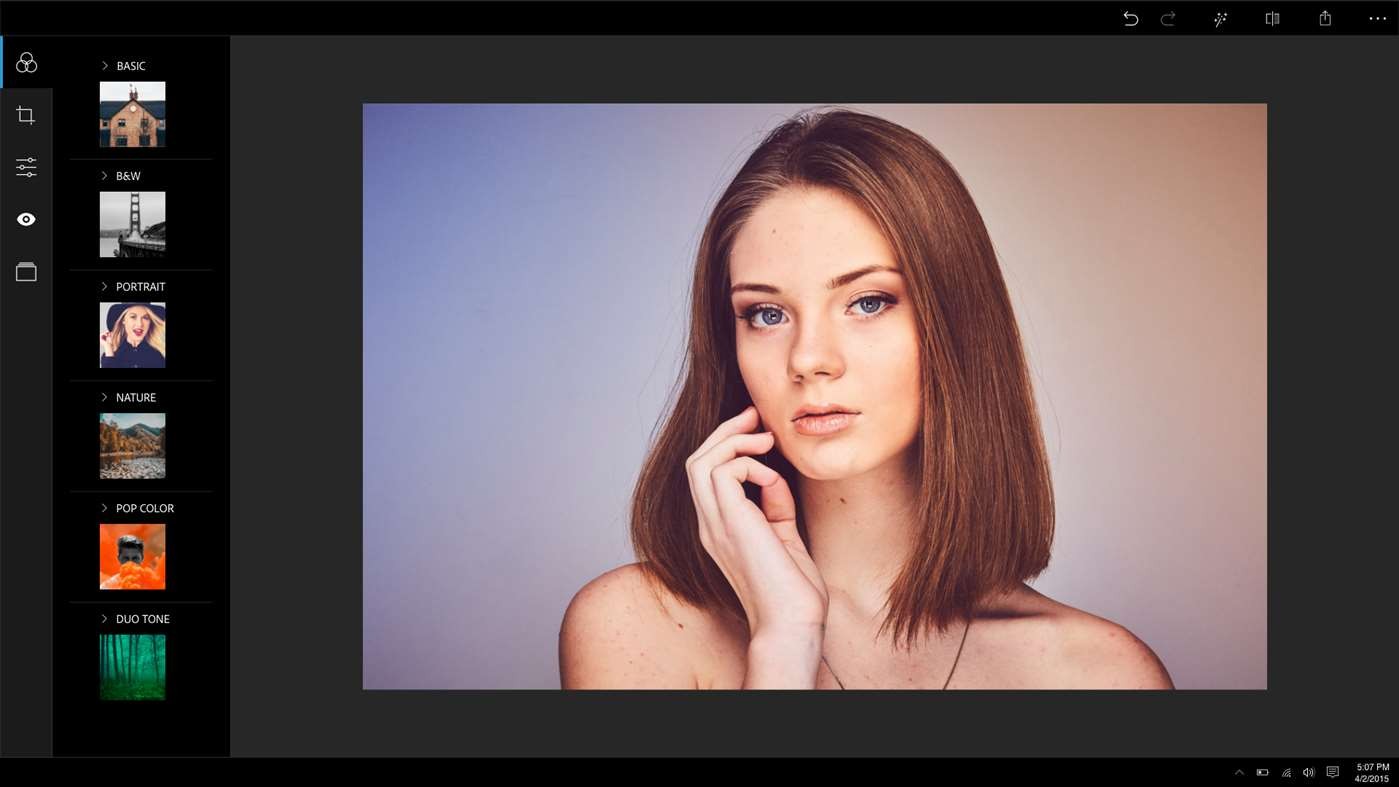
1. Adobe Photoshop Express for Windows
Specifications
Reasons to buy
Reasons to avoid
Given how expensive a Photoshop subscription is, you may be surprised that a number of its features are available in a free app called Photoshop Express. And not only is this available for mobile platforms, but there’s a version for PCs too, which you can download from the Windows Store. All you need is an Adobe ID, which is free to create and only takes a couple of moments.
Photoshop Express allows you to crop your images and enhance them using slider-based controls such as contrast, clarity, saturation, vibrance and dehaze. You can also add filters; fine-tune Exposure, Highlights and Shadows; and tweak things further with tools including Sharpen, Reduce Luminance Noise, and Reduce Color Noise. Blur, fade, vignette, spot heal and red-eye removal tools are also at your fingertips.
It doesn’t replicate everything in Photoshop; nowhere near, in fact. But it does feature a pretty decent set of tools for basic image editing. And as the name suggests, this lightweight app works quickly and efficiently, so you may even prefer it to the full-bodied Photoshop if you just need to make a few tweaks.
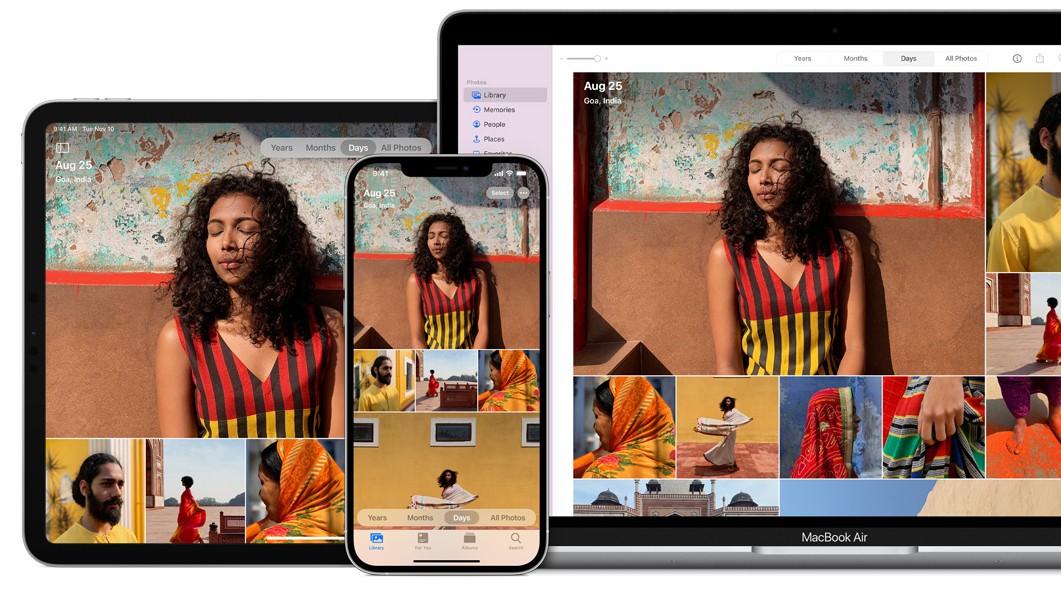
2. Apple Photos
Specifications
Reasons to buy
Reasons to avoid
If you have a Mac then you already have Apple Photos installed. And if you give it a try, you may find it provides everything you need, especially if you’re a beginner or just want to make a few basic edits to your photos.
With the kind of clean and minimal interface you expect from Apple, this app is aimed at general consumers and is suitably easy to use. As well as cropping your images, you can edit and enhance them using controls including brightness, contrast, saturation, white balance, curves, levels and vignette. Then, when you’ve made an edit, you can judge it against the original by clicking Compare. If you don’t like how it looks, you can reset your adjustments or revert to your original shot.
Apple Photos syncs everything with the iCloud, and does a great job of organising your photos, which is particularly useful if you have a ton of them spread across different i-devices. You can also add descriptions and keywords to help when searching for them later.
All this, plus photo filters inspired by classic photography styles, makes Apple Photos a more appealing prospect than most free photo editing software available for Mac; especially as you won’t be bothered by ads, watermarks or attempts to get you to upgrade to a paid version. The only caveat is that you’ll get just 5GB of cloud storage with iCloud, so if you need more, you'll have to pay.
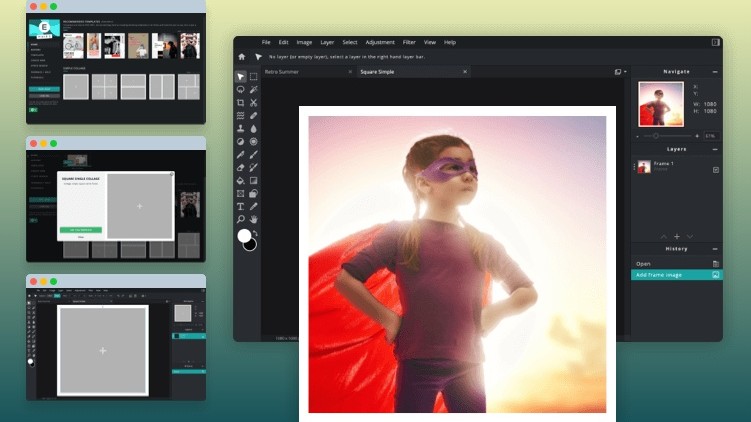
3. Pixlr E
Specifications
Reasons to buy
Reasons to avoid
These days, more and more software is becoming available in the browser. Many people find this more convenient, as there’s nothing to download, you don’t have to worry about the processing power of your computer, and you can access the app on any device with an internet connection. If this is something that interests you, then we’d urge you to check out Pixlr E. Not only can you bring it up just by clicking on the URL, you don’t even have to log in to use it.
This browser-based app is an offshoot of Pixlr X, which has long been one of our favourite online photo editors. Pixlr E builds on Pixlr X’s more basic toolset to offer a wider range of features that seasoned pros will appreciate.
A mixture of photo editor and graphic design app, Pixlr X’s interface is similar to Photoshop’s and allows you to make all the usual adjustments to brightness, contrast, temperature, tint, hue, saturation, colour balance, highlights, shadows, curves and more. Then there are the more advanced possibilities offered by the Marquee, Lasso, Wand, Cutout/Mask, Clone, Liquify, Blur and Dodge tools. You can make non-destructive edits to your images, the app integrates nicely with Dropbox and there’s a nice library of effects, too.
Be aware, though, that while the app works beautifully smoothly and quickly, it's plastered with intrusive ads and there's an artificial five-second delay built in when you save an image. This is because they REALLY want you to subscribe to the paid edition, which gives you AI-driven cutout tools and thousands of extra assets including stock content, overlays, icons, decorative texts and templates.
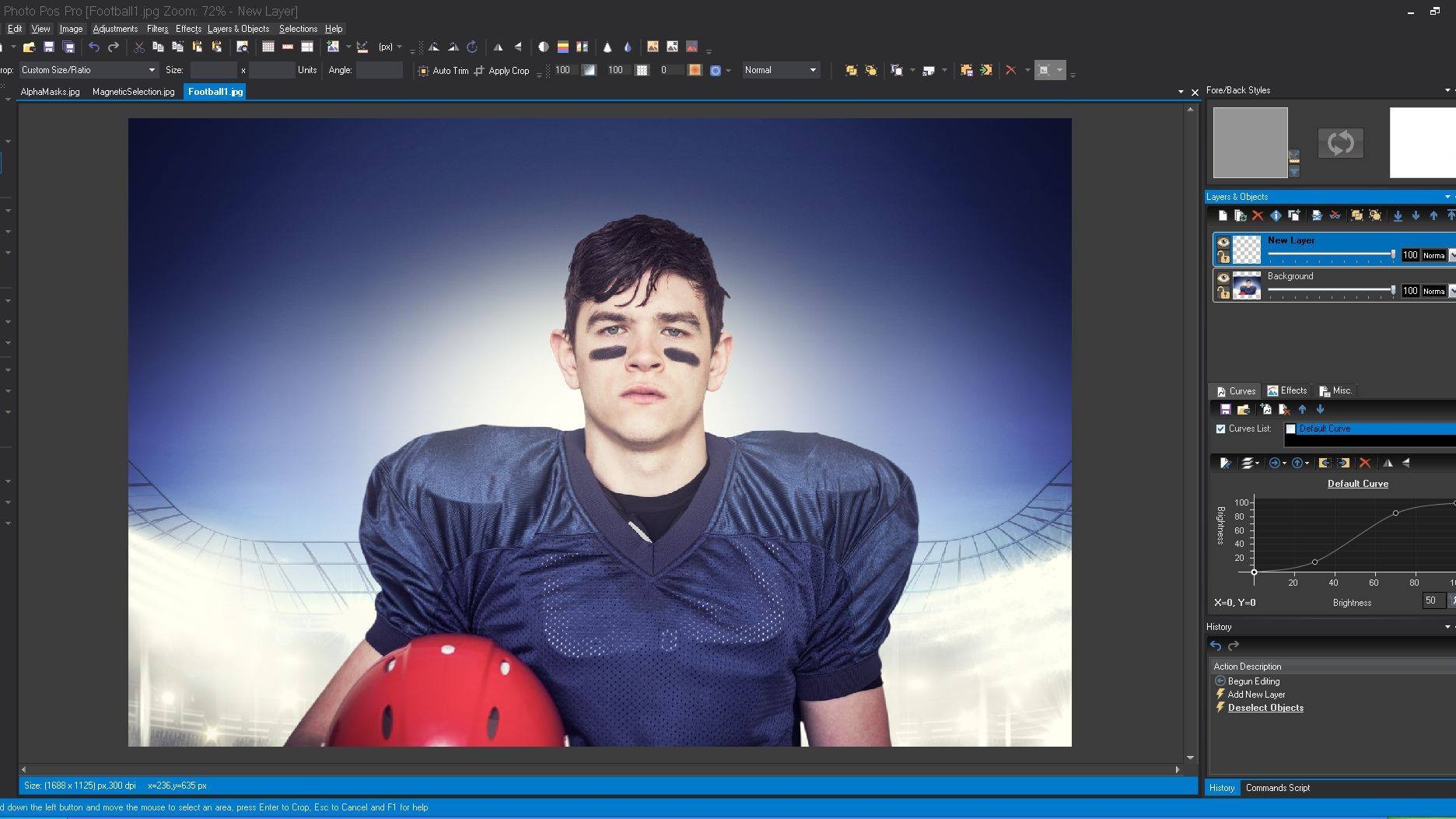
4. Photos Pos Pro
Specifications
Reasons to buy
Reasons to avoid
Photos Pos Pro may have a silly name, but this app for Windows has become one of the world’s most popular, with over 10 million downloads to date. It offers all the standard features you’d expect to see in photo editing software, including filters, layers, masks, curves, scripts, effects and brushes. It supports a range of file types, too, including RAW, GIF and PSD.
So is this app aimed at beginners or experts? Actually, it’s both. And to make that abundantly clear, Photos Pos Pro gives you a choice of two interfaces, depending on your skill level. The simpler one only provides the basic features, so newbies won’t be overwhelmed and can get up and running with editing photos quickly and easily. (There’s also an online help system to take you through everything step by step.)
More experienced users, meanwhile, will prefer the full interface, which gives you access to higher-level features such as layers. In truth, it's a bit cluttered and confusing, but as you're not paying it, you can't complain too much.
Photo Pos Pro also comes with some nice collage templates, and a good selection of filters and effects. If you want to upgrade, the paid-for version includes a larger number of templates, and sophisticated tools such as the ability to group objects and AI-driven selection.
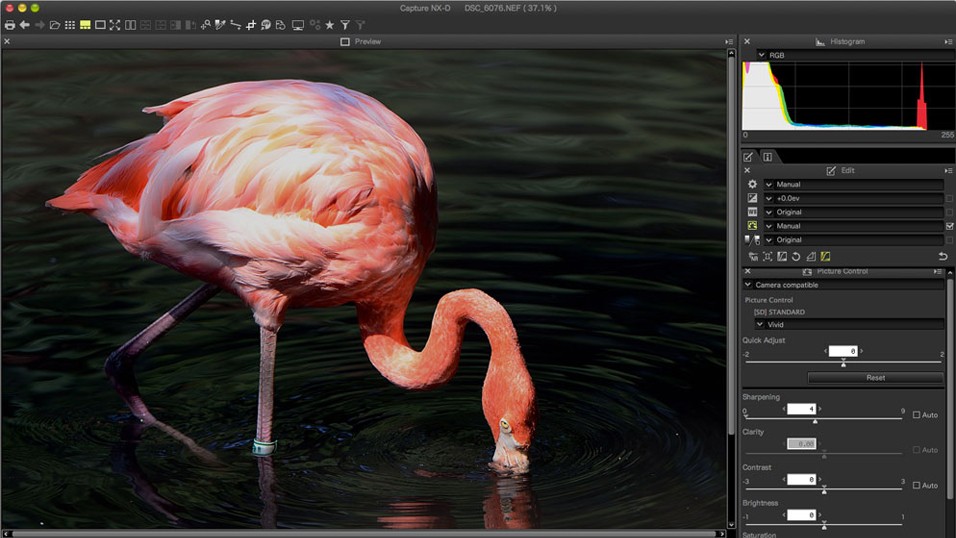
5. Capture NX-D for Nikon
Specifications
Reasons to buy
Reasons to avoid
It amazes us how many people go hunting for free photo editing software on the web, without even considering the highly capable apps they get free with their camera. Nikon’s Capture NX-D is a case in point.
Unlike most third party apps, this RAW conversion and enhancement software duplicates Nikon cameras’ own Picture Controls and white balance settings exactly. It produces very decent RAW conversions from Nikon NEF files. And it even offers local adjustments via Color Control Points.
While Adobe Camera Raw’s interface may be cleaner and easier to use, on the whole Nikon Capture NX-D’s noise reduction is superior. And consider the former requires a subscription and the latter comes free, you’d be daft not to at least give it a try.
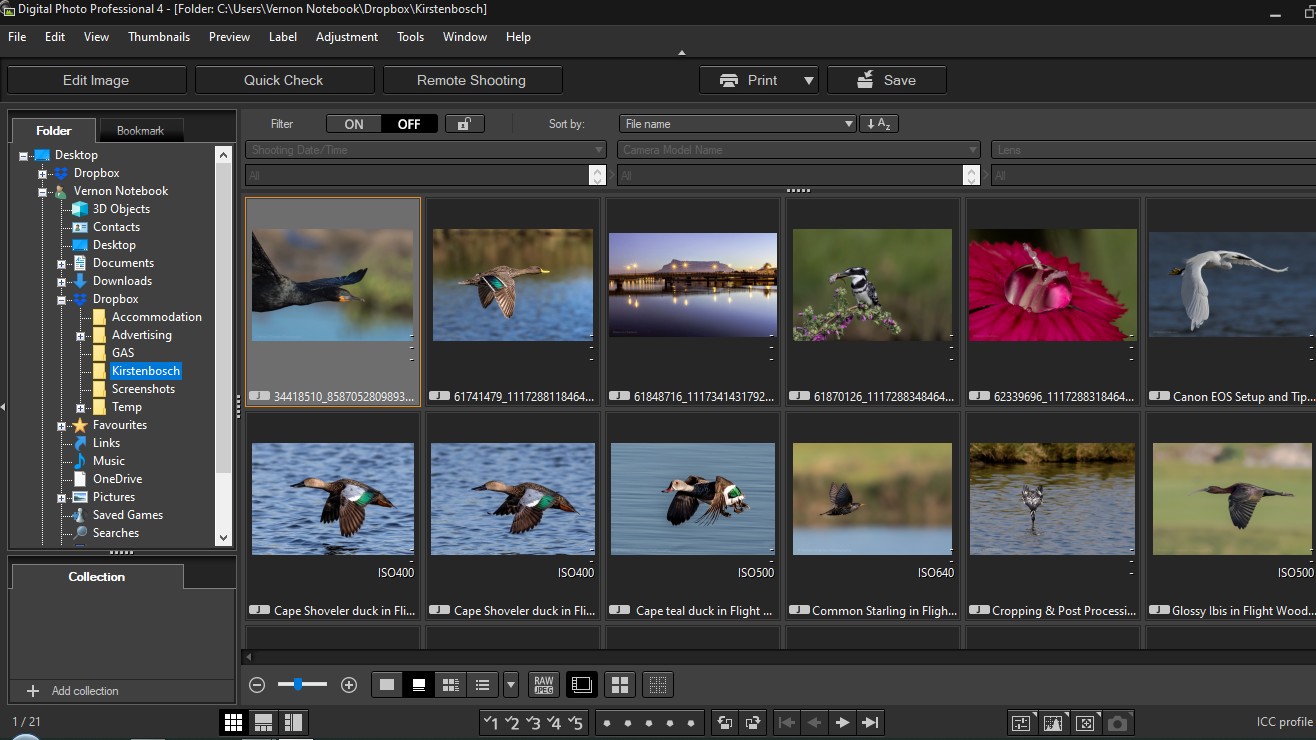
6. Digital Photo Professional for Canon
Specifications
Reasons to buy
Reasons to avoid
Canon users are blessed with some very decent free photo editing software as part of their camera purchase. Similarly to Nikon Capture NX-D (above), Digital Photo Professional gives you great results from RAW files with the minimum of effort. It’s tuned precisely for Canon cameras and lenses, utilising your camera's sophisticated built-in features – such as Auto Lighting Optimizer and Picture Styles – to enhance your images.
That said, there are some compromises to be made here. It’s not the fastest software around, and the interface feels quite outdated and cluttered. Plus most paid apps will have more advanced features that the free Canon software is missing, such as the ability to control vibrance and blacks/whites in Adobe Camera Raw.
On the other hand, Digital Photo Professional does offer perhaps the best combination of sharpness and noise control of any raw processing tool – yes, including Adobe Camera Raw and Lightroom. So if you’re a Canon user, it very much makes sense to download it and give it a try.
• See also How to use Canon Digital Photo Professional
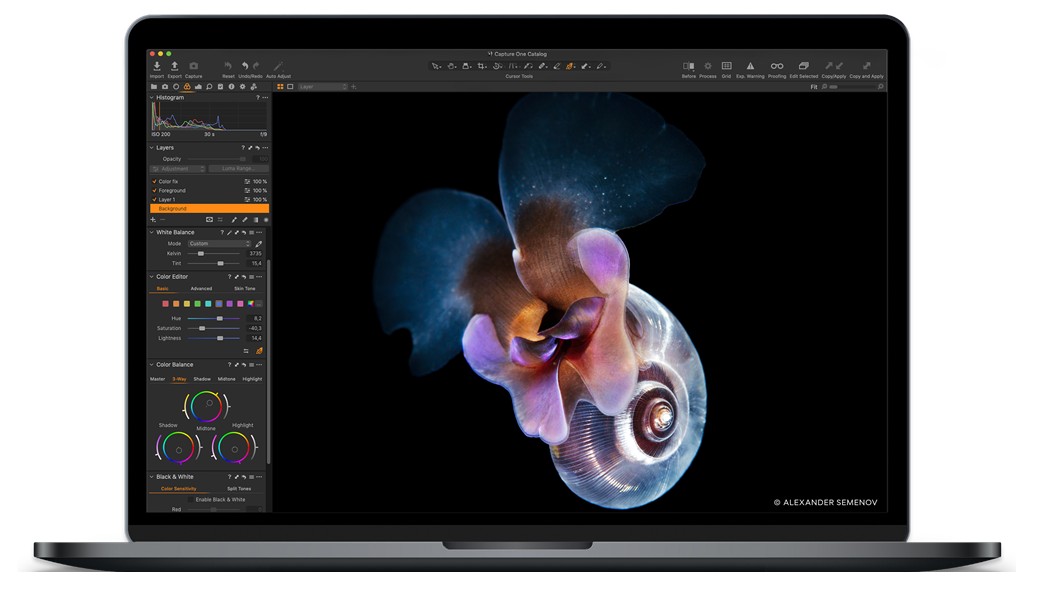
7. Capture One Express for Sony and Fujifilm
Specifications
Reasons to buy
Reasons to avoid
Camera software maker Phase One offers free ‘Express’ versions of its high-end Capture One image editing software specifically for Sony and Fujifilm users. And they’re well worth checking out, not least because their RAW editing features are superior to both camera brands' native apps.
Capture One Express also automatically adjusts your colours, brightness and more. Plus you can make your own edits using easy tools, or apply instant looks with Styles.
Phase One offers these tools for free as a way of tempting you into buying a perpetual licence, or a subscription, to the full versions. That way you get more sophisticated features for working with RAW files, including layers, levels, curves and advanced colour correction. But there’s no compulsion to upgrade from the free apps, which have a lot to offer by themselves.
Free mobile photo editors

1. Snapseed
Specifications
Reasons to buy
Reasons to avoid
First launched in 2011 and now owned by Google, Snapseed is very easy to use, with a clean and logical interface. And yet it’s packed with a wide range of powerful editing tools.
Crop and rotate your images, and use tools like Healing, White Balance and Lens Blur to enhance them. Apply filters like Glamour Glow, Noir, Grainy Film and Retrolux for impressive effects. Blend two photos for a double exposure effect. Use Face Enhance to add focus to the eyes. Add face-specific lighting. Smooth the skin. And the list goes on.
Unlike most mobile editing apps, Snapseed offers non-destructive editing and the ability to open and tweak RAW DNG files. You can also save specific looks and apply them to new photos later. These are just some a wide range of features that are quite surprising to find in a free app. But hey, Google can afford it, so why not take advantage?
As you’ve probably gathered, Snapseed is aimed at people with a bit of experience at photo editing, and newbies wanting to just make a few tweaks may prefer a simpler app. But otherwise, this is hands-down the best free photo editing software for mobile available today.
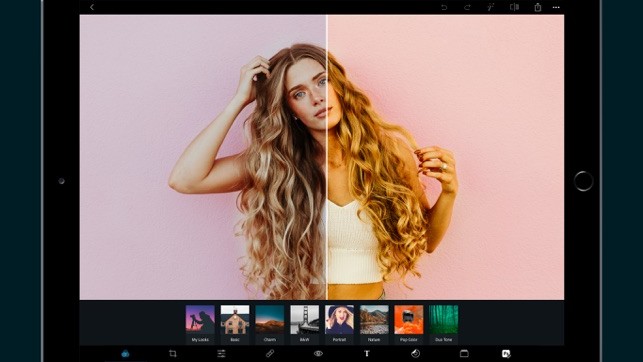
2. Photoshop Express
Specifications
Reasons to buy
Reasons to avoid
We’ve featured Photoshop Express in our selection of desktop software, as there’s a version for Windows. But it’s on mobile that the app makes most sense, as a way of making tweaks to your images while you're away from your main computer. It's free to download, but you do need an Adobe account. Don’t worry, though: this is free and quick to set up, and you don’t need a credit card.
Photoshop Express is by no means as powerful as Photoshop, but it does provide basic tools to make quick photo edits and create collages. You can also apply instant filters called Looks, and use a range of adjustment and correction options to touch up your images. You can crop your images to predetermined sizes for social networks like Facebook, Instagram, Pinterest, LinkedIn and Etsy. And you can work with RAW files, too. More advanced tools, meanwhile, are available with a Premium subscription.

3. Lightroom for Android/iPad/iPhone
Specifications
Reasons to buy
Reasons to avoid
Adobe’s photo editing and organisation software Lightroom is one of its most popular tools among photographers, but requires a fairly hefty subscription. If you’re light on budget, though, you’ll be pleased to know there’s a stripped down version that’s absolutely free. This allows you to capture, organise, edit, and share photos on your iPad, iPhone, or Android device.
We won’t sugar-coat it: to take advantage of most of this app’s features you’ll need a Creative Cloud subscription. These include batch editing, selective adjustments, the healing brush and more, as well as the ability to sync your photos across your devices.
That said, all of the capture, organization, and sharing features, and most of the editing tools of Lightroom for Mobile are still available in the free version. So even if you don’t have a Creative Cloud subscription, it’s still worth giving it a go.
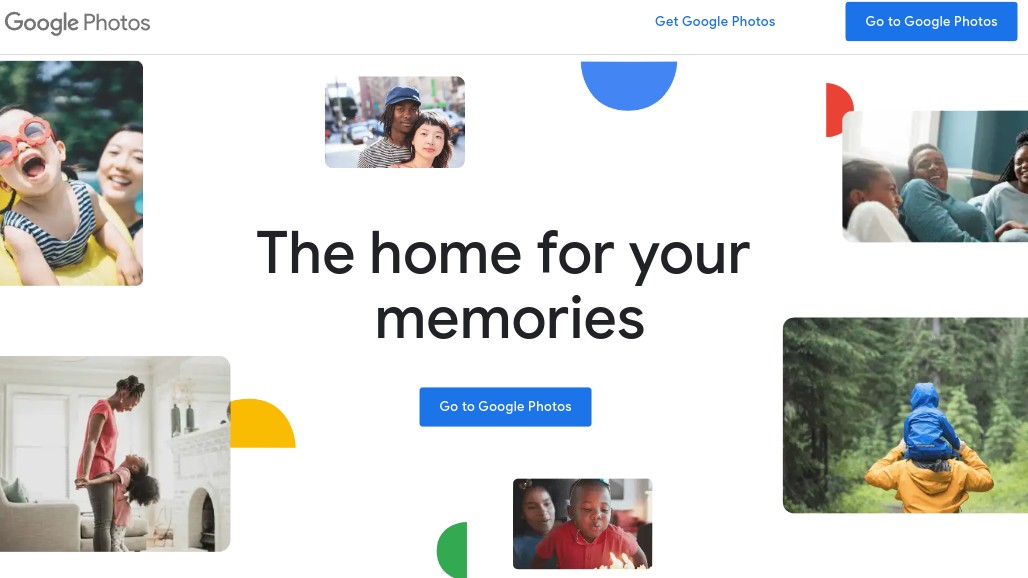
4. Google Photos
Specifications
Reasons to buy
Reasons to avoid
Google Photos lets you store photos in the cloud as part of the 15GB you get for free for Google apps overall (including Gmail, Google Drive and so on). It also has good image editing and organisation features, and some impressive AI tools.
The best of these is its facial recognition, which does an incredible job of identifying and grouping similar faces in your images. The AI can identify objects too, which means your photos are now searchable by the people, places and things in them – no tagging required.
Other nifty tools include the option to create a photo book; and you can even see suggested photo books, based on your best shots from a trip or period of time. Plus Google Photos offers a range of editing and enhancement tools. Along with the basics, you can do things like change the position and brightness of light for photos of people, and desaturate the background while keeping the foreground in colour. Google Photos even uses machine learning to give you suggestions tailored to the specific photo you’re editing.
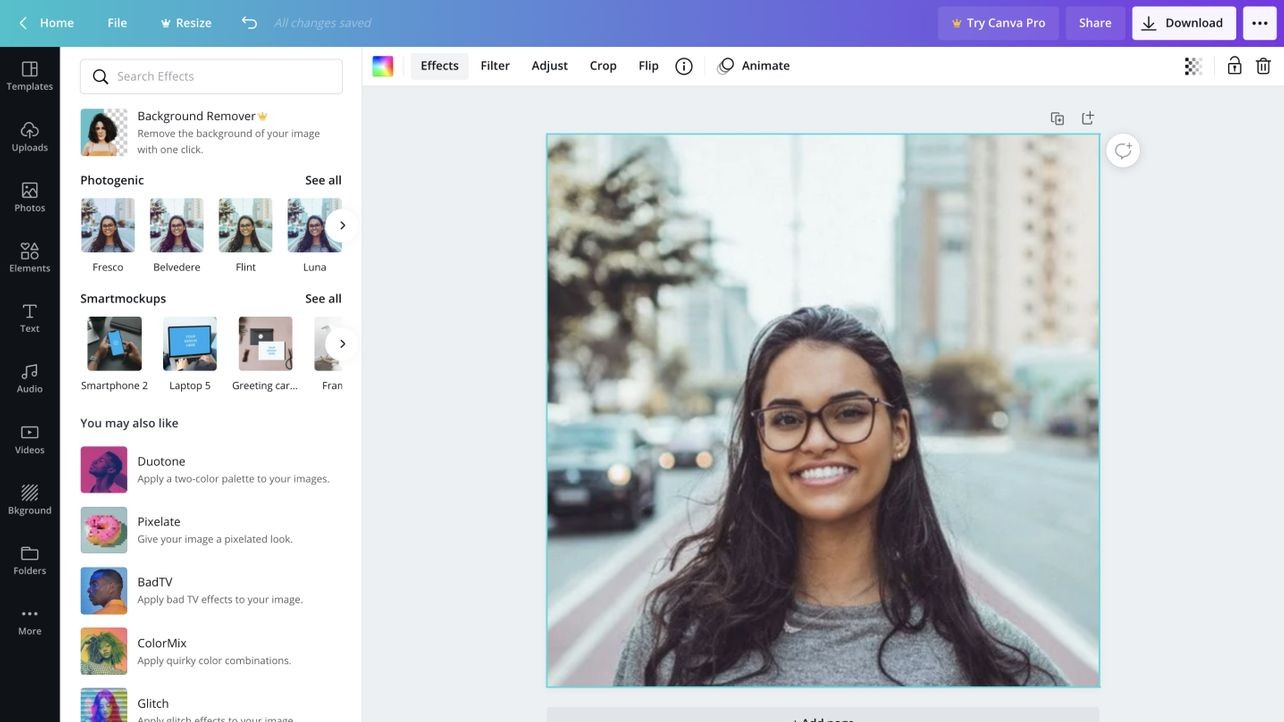
5. Canva
Specifications
Reasons to buy
Reasons to avoid
Canva is a graphic design and photo editing tool that’s available in your web browser and as a mobile app. Allowing you to filter, resize and edit your photos, it’s quick and easy to use, and a great choice for beginners.
While there’s a premium version with more features (such as the automatic background remover), the free version is fine for making basic photo edits such as cropping, resizing, sharpening, adjusting brightness, contrast and saturation, applying filters tints and vignette effects, and adding text to images. The filters are editable, too, and unlike many free photo editing apps, Canva doesn’t add watermarks or require any plugins.
Let’s be clear: the photo editing capabilities of Canva are pretty limited, and this is mainly geared towards template-driven graphic design. But this lightweight app is so quick and easy to use, that even many Photoshop owners like using it to make quick tweaks to their images.
Read more:
Get the Digital Camera World Newsletter
The best camera deals, reviews, product advice, and unmissable photography news, direct to your inbox!
Tom May is a freelance writer and editor specializing in art, photography, design and travel. He has been editor of Professional Photography magazine, associate editor at Creative Bloq, and deputy editor at net magazine. He has also worked for a wide range of mainstream titles including The Sun, Radio Times, NME, T3, Heat, Company and Bella.
